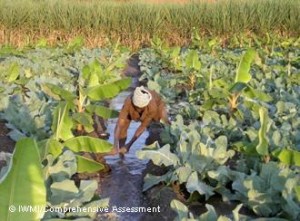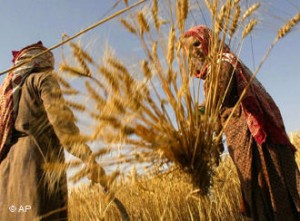Sustainable Agriculture: A Recipe

By the year 2050, there’s expected to be 9 billion people living on our planet. Can we feed all those people without destroying the earth? That’s the question a new report is trying to answer. A team of researchers from the U.S., Canada, Sweden and Germany worked together on a major article that will be published in Nature journal in a few days, and their conclusion is this: the only way forward is to create a global plan for sustainable agriculture.
What is that plan? According to the researchers, it will include key steps like halting farmland expansion into our tropics, using existing farmland more effectively, changing our diet patterns and cutting down on the food waste we produce. And those steps are crucial to keeping the planet healthy. Farm land and pastures now cover about 40% of our planet and agriculture accounts for a third of all the emissions produced around the globe. If there’s a sustainable solution to the future of farming and producing food, it could mean a major breakthrough for our environment.
How many praying mantises does it take to power a smartphone?
That question above was asked by Qualcomm, an American wireless telecommunications development company from San Diego. Well, they have created somewhat of a flea circus to charge a cell phone. Hopefully the insects have been treated well for this commercial, but, at least, it looks kind of funny. What do you think of that idea?
World Food Day

Today is World Food Day, a yearly event organized by the UN’s Food and Agriculture Organization (FAO). World Food Day is meant to raise awareness about global hunger and poverty, and this year the focus is squarely on how soaring food prices are affecting the world’s most vulnerable and poor. The theme is ”Food Prices-From Crisis to Stability.”
Climate change has a big impact on food prices. As the global supply of staple crops like corn and wheat gets more expensive, the cost of food goes up too. And the hardest hit areas, according to the FAO, are usually the world’s poorest. The FAO hopes bringing awareness to the issue will spur leaders around the globe to take action and address the problem at its source. There’s a list of events on the FAO’s website with ways you, too, can get involved!
Cooking smoke a greater killer than Malaria
Lots of money and effort has gone into awareness raising, public health campaigns and law suits in a bid to wean the world off smoking. Lots of money and effort also continues to go into the prevention and treatment of malaria. But there’s another type of smoke that some three billion people around the globe can’t escape and that, according to recent findings, kills more than Malaria.
According to the World Health Organization almost half the world’s population cook their food and heat their homes using open fires or leaky stoves that run on wood, coal or biomass. And nearly two million people die prematurely as a result of inhaling the smoke day in and day out. That makes it a greater killer than malaria. Women and children are particularly affected as they tend to spend more time at home while men are working outside.
But there are also other problems with open wood fires. They emit CO2 and the wood used for cooking is often logged unsustainably. GLOBAL IDEAS has reported on clean and safe alternatives.
Efficient stoves in Peru Click here to learn more
Solar cookers in India Click here to learn more
”Taste the Waste”
„Taste the Waste“ — Der Trailer from tastethewaste.com on Vimeo.
German director Valerie Thurn has come out with a new documentary called ”Taste the Waste” that highlights the effect of wasting food on the environment. It’s an eye-opening glimpse into the way food is produced and consumed around the world, and how much we end up throwing away. Did you know that 50% of all groceries end up in the trash? It’s not just at home, either – bakeries, supermarkets and convenience stores all end up tossing a big percentage of their products that aren’t sold.
Agriculture is one of the biggest culprits when it comes to greenhouse gases, and when half of it ends up in the garbage, it’s even worse: rotting food releases methane into the air, contributing to global warming. The US Department of Agriculture and CleanMetrics Corp. did this study to show how different foods produce greenhouse gases:

In the U.S. alone, people waste 55 million tons of food a year – about 40 percent of the food supply. So what can be done? Go check out the movie if you can, the director has some interesting solutions to the waste problem…








Feedback